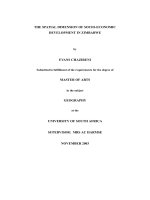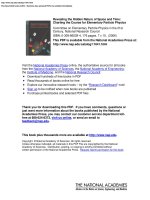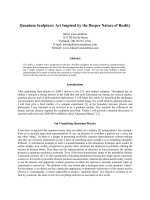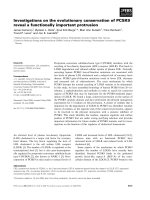- Trang chủ >>
- Đại cương >>
- Kinh tế vĩ mô
emergent design the evolutionary nature of professional software development
Bạn đang xem bản rút gọn của tài liệu. Xem và tải ngay bản đầy đủ của tài liệu tại đây (6.39 MB, 441 trang )
Emergent Design
The Evolutionary Nature of
Professional Software Development
Scott L. Bain
Upper Saddle River, NJ • Boston • Indianapolis • San Francisco
New York • Toronto • Montreal • London • Munich • Paris • Madrid
Capetown • Sydney • Tokyo • Singapore • Mexico City
Illustrations by Andrea Chartier Bain
Many of the designations used by manufacturers and sellers to distinguish their products are claimed as trademarks.
Where those designations appear in this book, and the publisher was aware of a trademark claim, the designa-
tions have been printed with initial capital letters or in all capitals.
The author and publisher have taken care in the preparation of this book, but make no expressed or implied war-
ranty of any kind and assume no responsibility for errors or omissions. No liability is assumed for incidental or con-
sequential damages in connection with or arising out of the use of the information or programs contained herein.
The publisher offers excellent discounts on this book when ordered in quantity for bulk purchases or special sales,
which may include electronic versions and/or custom covers and content particular to your business, training goals,
marketing focus, and branding interests. For more information, please contact:
U.S. Corporate and Government Sales
(800) 382-3419
For sales outside the United States please contact:
International Sales
V
isit us on the Web: informit.com/aw
Library of Congress Cataloging-in-Publication Data
Bain, Scott L.
Emergent design : the evolutionary nature of professional software development / Scott L. Bain.
p. cm.
Includes index.
ISBN 978-0-321-50936-9 (hardcover : alk. paper) 1. Computer software—Development. 2. Computer
software—Development—Vocational guidance. I. Title.
QA76.76.D47B345 2008
005.1—dc22
2007050637
Copyright © 2008 Pearson Education, Inc.
All rights reserved. Printed in the United States of America. This publication is protected by copyright, and per-
mission must be obtained from the publisher prior to any prohibited reproduction, storage in a retrieval system,
or transmission in any form or by any means, electronic, mechanical, photocopying, recording, or likewise. For
information regarding permissions, write to:
Pearson Education, Inc
Rights and Contracts Department
501 Boylston Street, Suite 900
Boston, MA 02116
Fax: (617) 671-3447
ISBN-13: 978-0-321-50936-9
ISBN-10: 0-321-50936-6
Text printed in the United States on recycled paper at Courier in Westford, Massachusetts.
First printing, March 2008
To Alan Shalloway and all instructors
and staff at Net Objectives, whose collegial
support and innovative ideas have
contributed endlessly to my
development as a technologist
and educator.
And . . .
To Andrea and Griffin, who have enriched
my entire life, and for whom I do pretty
much everything I do.
This page intentionally left blank
Contents
Series Foreword ___________________________________________________________xvii
Preface _____________________________________________________________________xxiii
Acknowledgments ________________________________________________________xxix
About the Author__________________________________________________________xxxi
Chapter 1
Software as a Profession___________________________________1
How Long Have Human Beings Been Making Software?________________1
What Sort of Activity Is Software Development? ______________________2
What Is Missing? __________________________________________________6
Who Is Responsible? _______________________________________________8
Uniqueness _______________________________________________________9
Chapter 2
Out of the Closet, Off to the Moon _______________________11
Patterns and Professionalism in Software Development________________11
Andrea’s Closet __________________________________________________12
Off to the Moon __________________________________________________18
Forces Lead to Forces ________________________________________22
Different Forces, Different Design ______________________________22
And There Are More Contextual Forces ________________________23
The Costs and Benefits _______________________________________24
On to Mars _________________________________________________26
vii
The Value of Patterns _____________________________________________26
Summary________________________________________________________27
Chapter 3
The Nature of Software Development __________________29
We Fail Too Much ________________________________________________30
Definitions of Success _____________________________________________31
The Standish Group ______________________________________________32
Doing the Wrong Things __________________________________________34
Doing the Things Wrong __________________________________________35
Time Goes By, Things Improve _____________________________________38
One Reason: The Civil Engineering Analogy _________________________38
Giving Up Hope __________________________________________________41
Ignoring Your Mother_____________________________________________42
Bridges Are Hard, Software Is Soft __________________________________43
We Swim in an Ocean of Change ___________________________________43
Accept Change ___________________________________________________44
Embrace Change _________________________________________________45
Capitalize on Change _____________________________________________46
A Better Analogy: Evolving Systems ________________________________49
Summary________________________________________________________52
Chapter 4
Evolution in Code: Stage 1 ________________________________55
Procedural Logic Replaced with Object Structure _____________________56
The Origins of Object Orientations and Patterns ______________________56
An Example: Simple Conditionals and the Proxy Pattern ______________58
The Next Step: Either This or That __________________________________62
Why Bother? ____________________________________________________65
One Among Many________________________________________________66
Summary________________________________________________________67
viii Contents
Chapter 5
Using and Discovering Patterns _________________________69
Design from Context: More Carpentry from Scott_____________________70
Patterns Lead to Another Cognitive Perspective ______________________79
Patterns Help Give Us a Language for Discussing Design _______________79
Patterns in This Book _____________________________________________80
Summary________________________________________________________81
Chapter 6
Building a Pyramid _________________________________________83
Elements of the Profession_________________________________________83
A Visual Representation ___________________________________________85
Summary________________________________________________________86
Chapter 7
Paying Attention to Qualities and Pathologies _________89
Encapsulation____________________________________________________91
Cohesion ________________________________________________________91
Method Cohesion____________________________________________92
Cohesion of Perspective Level _________________________________94
Class Cohesion ______________________________________________96
How Cohesive Is Cohesive Enough? ___________________________98
Coupling ________________________________________________________99
Intentional Coupling Versus Accidental Coupling ________________99
Types of Coupling __________________________________________101
Redundancy ____________________________________________________106
Redundancy and Coupling___________________________________110
Testability ______________________________________________________112
Readability _____________________________________________________114
Pathologies _____________________________________________________114
Indicators of Weak Cohesion _________________________________115
Indicators of Accidental or Illogical Coupling ___________________116
Indicators of Redundancy____________________________________118
Summary ______________________________________________________119
Contents ix
Chapter 8
Paying Attention to Principles and Wisdom ___________121
Separating Use from Creation _____________________________________122
Fowler’s Perspectives________________________________________122
Another Kind of Perspective _________________________________123
The Perspective of Use ______________________________________125
A Separate Perspective: Creation _____________________________125
Considering Construction Details Last _________________________127
The Real World_____________________________________________129
The Open-Closed Principle _______________________________________129
Open-Closed at the Class Level _______________________________131
Open-Closed at the Method Level ____________________________132
The Dependency Inversion Principle _______________________________133
Advice from the Gang of Four_____________________________________135
Designing to the Interface of a Method ________________________136
Designing to the Interface of a Class___________________________138
GoF: Favor Object Aggregation Over Class Inheritance __________139
GoF: Consider What Should Be Variable in Your Design and
Encapsulate the Concept That Varies ___________________________143
Summary ______________________________________________________146
Chapter 9
Paying Attention to Practices ___________________________147
Consistent Coding Style __________________________________________148
Comments_________________________________________________149
Naming Classes, Methods, and Variables _______________________151
Virtues of Coding Standards__________________________________152
Programming by Intention _______________________________________153
Are They Really All Private? _________________________________154
Encapsulating the Constructor ____________________________________155
Principles Versus Practices ___________________________________159
Making the Decision ________________________________________159
Commonality-Variability Analysis _________________________________161
Practices and Freedom ___________________________________________166
Summary ______________________________________________________167
x Contents
Chapter 10
Paying Attention to Disciplines: Unit Testing__________169
Economies of Testing ____________________________________________169
Unit Testing________________________________________________171
Up-Front Testing ___________________________________________173
JUnit Framework________________________________________________175
JUnit Basics________________________________________________176
JUnit Examples ____________________________________________178
Rule.java: Code First, Then Test ______________________________179
RuleContainer.java: Test First, Then Code______________________187
Eliminating Redundancy: @Before and @After _________________196
Automating Tests in Batches _________________________________199
Exceptions and Unit Testing__________________________________200
Mock Objects ___________________________________________________204
MockObject Frameworks ____________________________________206
Faking It __________________________________________________209
Dependency Injection and the Endo-Testing Technique__________210
Endo-Testing_______________________________________________211
Summary ______________________________________________________212
Chapter 11
Paying Attention to Disciplines: Refactoring __________213
Refactoring Bad Code ____________________________________________215
Refactoring Good Code___________________________________________216
Structural Changes Versus Functional Changes______________________218
Refactoring Helps You Choose Your Battles _________________________219
Patterns Can Be Targets of Refactoring _____________________________220
Avoiding Refactoring: Prefactoring_________________________________220
The Mechanics of Refactoring _____________________________________221
Refactoring Legacy Code _________________________________________231
Summary ______________________________________________________233
Contents xi
Chapter 12
Test-Driven Development _______________________________235
What Makes Development Test-Driven?____________________________235
Test-Driven Versus Test-First _________________________________236
Designing from the Perspective of the Unit Test_________________237
Testing and Quality ______________________________________________238
Testing and Cohesion _______________________________________238
Testing and Coupling________________________________________240
Testing and Redundancy_____________________________________240
Test-Driven Development and Patterns_____________________________241
The Strategy Pattern ________________________________________241
Turtles All the Way Down ___________________________________242
Mock Object/Mock Turtles ___________________________________243
Mock Objects ___________________________________________________244
Mock Turtles____________________________________________________248
Testing the Decorator Pattern _____________________________________248
Summary ______________________________________________________253
Chapter 13
Patterns and Forces _____________________________________255
Making Decisions in an Evolving Design ___________________________255
Christopher Alexander and Forces_________________________________256
The Signal Processor Example ________________________________257
The PKZip Example _________________________________________262
Testing and Forces __________________________________________265
More Choices, More Forces _______________________________________266
Summary ______________________________________________________271
Chapter 14
Emergent Design: A Case Study _______________________273
The Problem Domain: The MWave Corporation _____________________273
The Teams______________________________________________________275
The Simplest Thing That Could Possibly Work_______________________277
xii Contents
A New Requirement: Complex Machines___________________________281
Oh, By the Way _________________________________________________283
More Good News________________________________________________285
Summary: What a Long, Strange Trip It Has Been ___________________287
Chapter 15
A Conclusion: 2020 ______________________________________289
Appendix A
Evolutionary Paths________________________________________291
Encapsulated Constructor to Singleton ________________________292
Programming-by-Intention to Encapsulated Constructor to
Strategy (Varying on an Issue Extrinsic to the Client) ________293
Programming-by-Intention to Encapsulated Constructor to
Strategy (Varying on an Issue Intrinsic to the Client) ________294
Programming-by-Intention to Encapsulated Constructor to
Chain of Responsibility (Varying on an Issue Extrinsic
to the Client) ___________________________________________295
Programming-by-Intention to Encapsulated Constructor to
Chain of Responsibility (Varying on an Issue Intrinsic to
the Client) _____________________________________________296
Encapsulated Construction to Strategy to Singleton (Object
Factory) to Adapter/Façade ______________________________297
Encapsulated Constructor to Proxy to Decorator with Singleton
(Object Factory) ________________________________________299
Appendix B
Overview of Patterns Used in the Examples__________301
The Abstract Factory Pattern ______________________________________303
Contextual Forces __________________________________________303
Implementation Forces ______________________________________305
Consequent Forces _________________________________________309
Contents xiii
The Adapter Pattern _____________________________________________310
Contextual Forces __________________________________________310
Implementation Forces ______________________________________312
Consequent Forces _________________________________________314
The Bridge Pattern ______________________________________________315
Contextual Forces __________________________________________315
Implementation Forces ______________________________________316
Consequent Forces _________________________________________320
The Chain of Responsibility Pattern________________________________321
Contextual Forces __________________________________________321
Implementation Forces ______________________________________322
Consequent Forces _________________________________________326
Chain of Responsibility: The Poker Example ___________________327
The Composite Pattern ___________________________________________329
Contextual Forces __________________________________________329
Implementation Forces ______________________________________332
Consequent Forces _________________________________________336
The Decorator Pattern____________________________________________337
Contextual Forces __________________________________________337
Implementation Forces ______________________________________339
Consequent Forces _________________________________________345
The Façade Pattern ______________________________________________346
Contextual Forces __________________________________________346
Implementation Forces ______________________________________348
Consequent Forces _________________________________________356
The Proxy Pattern _______________________________________________358
Contextual Forces __________________________________________358
Implementation Forces ______________________________________360
Consequent Forces _________________________________________362
The Singleton Pattern ____________________________________________364
Contextual Forces __________________________________________364
Implementation Forces ______________________________________365
Consequent Forces _________________________________________370
xiv Contents
The Strategy Pattern _____________________________________________371
Contextual Forces __________________________________________371
Implementation Forces ______________________________________373
Consequent Forces _________________________________________376
The Template Method____________________________________________377
Contextual Forces __________________________________________377
Implementation Forces ______________________________________379
Consequent Forces _________________________________________383
Appendix C
The Principle of the Useful Illusion_____________________385
My View _______________________________________________________385
An Alternate View_______________________________________________389
Bibliography _______________________________________________________________393
Index________________________________________________________________________395
Contents xv
This page intentionally left blank
I
f you are like me, you will just skim this series foreword and move on,
figuring there is nothing of substance here. That would be a mistake.
Unless you have read this foreword in another book in the series, please
take a moment with me at the outset of this book. I want to consider with
you a tale that most people know but don’t often think about. That tale
is about what is ailing this industry. And that tale sets the context for why
we created the Net Objectives Product Development Series and this par-
ticular book.
I have been doing software development since 1970. To me, it is just
as fresh today as it was almost four decades ago. It is a never-ending source
of fascination to me to consider how to do something better and it is a
never-ending source of humility to have to confront how limited my abil-
ities truly are. I love it.
Throughout my career, I have also been interested in other industries,
especially engineering and construction. Now, engineering and construc-
tion have suffered some spectacular failures: the Leaning Tower of Pisa,
the Tacoma Narrows Bridge, the Hubble Telescope. In its infancy, engi-
neering knew little about the forces at work. Mostly, engineers tried to
improve practices and to learn what they could from failures. It took a long
time—centuries—before they had a solid understanding about how to do
things. Does that mean that we, software developers, have an excuse to
take longer than we need before we understand how to do things? No!
No one would build a bridge without taking into account well-known
practices of bridge building (stress, compression, and the like), but soft-
ware developers get away with writing software every day based on “what
they like” with little or no complaint from their peers. Why do we work
this way?
xvii
Series Foreword
The Net Objectives Product
Development Series
Alan Shalloway, CEO, Net Objectives
However, this is only part of the story. Ironically, much of the rest is
related to why we call this the “Net Objectives Product Development
Series.” The Net Objectives part is pretty obvious. All of the books in this
series were written either by Net Objectives staff or by those whose views
are consistent with ours. Why “Product Development”? Because when
building software, it is always important to remember that software devel-
opment is really product development.
Michael Kennedy, in his 2003 book, Product Development for Lean Enterprise,
defines product development as “the collective activities, or system, that a
company uses to convert its technology and ideas into a stream of products
that meet the needs of customers and the strategic goals of the company.”
Mary and Tom Poppendieck, in their excellent book, Implementing Lean
Software Development: From Concept to Cash (2006), note:
It is the product, the activity, the process in which software is
embedded that is the real product under development. The soft-
ware development is just a subset of the overall product devel-
opment process. So in a very real sense, we can call software
development a subset of product development. And thus, if we
want to understand lean software development, we would do
well to discover what constitutes excellent product development.
In other words, software—in itself—isn’t important. It is the value that
it contributes—to the business, to the consumer, to the user—that is
important. When developing software, we must always remember to look
at what value is being added by our work. At some level, we all know
this. But so often organizational “silos” work against us, keeping us from
working together, from focusing on efforts that create value.
The best—and perhaps only—way to achieve effective product devel-
opment across the organization is a well-thought-out combination of lean
principles to guide the enterprise, agile practices to manage teams, and
technical skills (test-driven development, design patterns). That is the
motivation for the Net Objectives Product Development Series.
For too long this industry has suffered from a seemingly endless swing
of the pendulum from no process, to too much process, and then back to
no process—from heavyweight methods focused on enterprise control to
disciplined teams focused on the project at hand. The time has come for
management and individuals to work together to maximize the produc-
tion of business value across the enterprise. We believe lean principles
will give us guidance in this.
xviii Series Foreword
Lean principles tell us to look at the systems in which our work takes
place and then relentlessly improve them in order to improve our speed
and quality (which will drive down cost). This requires
• Teams to own their systems and continuously improve them
• Management to train and support their teams to do this
• An appreciation for what constitutes quality work
It may feel like we are very far from achieving this in the software devel-
opment industry, but the potential is definitely there. A lean approach
helps with the first two principles, and an understanding of technical
programming and design has matured far enough to help us with the third.
As we incorporate into existing coding and analysis approaches the dis-
cipline, mindset, skills, and focus on the value of lean, agile, patterns, and
test-driven development, we will help software development move from
being merely a craft to being a true profession. We have the knowledge
required to do this; what we need is a new attitude.
The Net Objectives Product Development Series helps to develop this
attitude. We aim to help integrate management and individuals in work
efforts that “optimize the whole”:
1.
The whole organization: Integrating enterprise, team, and indi-
viduals to best work together.
2.
The whole product: Not just its development, but also its mainte-
nance and integration.
3.
The whole of time: Not just now, but in the future. We want sus-
tainable ROI from our effort.
Emergent Design:
The Evolutionary Nature of
Professional Software Development
This particular book addresses the technical dimensions of product devel-
opment. It describes what we mean by software becoming a profession.
At the same time, it discusses the necessity of building software in an
evolutionary way. However, this evolution of a design is not ad hoc by
any means. It is guided by well-defined and proven measures of qual-
ity. It is these measures that we must pay attention to when making
decisions.
Series Foreword xix
While hard-and-fast rules cannot be applied everywhere, principles
can be. Ten years ago, the argument that we did not have a well-estab-
lished set of rules may have carried water. That is no longer true.
Back in 1984, I began my own exploration of what quality software
meant. I remember the year well, because of an incident that occurred and
two questions that occurred to me as a result. The incident was the dis-
covery of a bug, after which I asked myself, “What was I doing that I put
a bug in my code?” My first reaction was to realize that I always talked
about finding bugs, like I didn’t put them in there. You don’t walk out to
your driveway in the morning and say, “Look what I found! My car!”
(Okay, okay, I actually do this with my car keys, but that’s a different
story.) In other words, we talk about bugs as if they just show up—not as
if we put them in the system. I assure you, gremlins are not coming into
your programs in the middle of the night and inserting bugs into your
code. The realization I had was to ask, “How could it take me 14 years to
ask this question?” (This is how I remember it was 1984.)
It wasn’t as if I had never wondered how to become a better program-
mer. It is just that it required more introspection and retrospection than
I was used to: about what I did and how I could do it better. I needed to
take an “outsider’s view” to be able to study the system of programming.
What can be done to improve it?
Many of us have embarked on this journey. It has given rise to the
object-oriented languages, the elucidation of the proper use of design pat-
terns,
1
and agile programming methods such as test-driven development.
It is very clear that we know enough of the basics of what software devel-
opers must pay attention to, that merely appealing to what we like or
don’t like is not sufficient. We must be able to demonstrate that we have
found a better way or we must follow what the industry has proven to be
effective.
This is not an enforcement of standards from above. This is a matter of
developers accepting the responsibility to build upon the shoulders of
others. We must recognize that we cannot reinvent the wheel every time,
and that just because we don’t understand something doesn’t mean it is
not something of value. We must look to best practices when possible and
adjust them as necessary.
xx Series Foreword
1. See Shalloway and Trott, Design Patterns Explained: A New Perspective on Object-Oriented Design,
Second Edition. Addison-Wesley, 2005.
The End of an Old Era, the Beginning of a New One
I believe the software industry is at a crisis point. The industry is contin-
uously expanding and becoming a more important part of our lives every
day. But software development groups are facing dire problems. Decaying
code is becoming more problematic. There seems to be no end in sight to
the burden on an overloaded workforce. While agile methods have
brought great improvements to the many teams, more improvements are
needed. By creating a true software profession, combined with the guid-
ance of lean principles and incorporating agile practices, we believe we can
help uncover the answers.
I hope you find this series to be a worthy guide. To assist you along the
way, we have created a resources page at our Web site (http://www.
netobjectives.com/resources), which Scott refers to in several places in
this book. You should know that the site also contains much information
outside the scope of this book. You will find resources on the other com-
ponents of our lean-agile approach, including lean, agile, scrum, design
patterns, and more. Please visit it and take advantage of what it offers.
Series Foreword xxi
This page intentionally left blank
D
esigning and creating software is hard.
I like that it’s hard. I like a challenge. I like solving puzzles. That’s prob-
ably what attracted me to computers and programming in the first place.
It’s just that it’s a little bit too hard. I don’t want it to be easy; I’m not
asking for that. I just want it to be a little easier, a little more predictable,
and a little less chaotic.
I’d like to be able to tell someone, at the beginning of a project, what
my software will generally be able to do when it’s done, and feel confi-
dent that I’m right in what I’m saying. I’d like to be able to tell how long
it will take to get the project done, and how much, generally, it will cost.
And, I would like to be successful in these predictions and estimates—at
least most of the time.
I’d like to feel like I know what I’m doing. Really know.
Anyone who has developed any complex software has surely had this
experience: at about month 9 of a 12-month project, we’re fine; we’re
on-track. At month 10, we’re 4 months behind. How is that possible?
Obviously, we were not fine at month 9—we just thought we were. Why
didn’t we know?
Or, perhaps we have a working system, one that seems just fine, and
then the end users want some new function or capability. It is a reason-
able request. Things change; we know that. The pace and scope of change
in our world is on the rise.
But when we try to make the change the customer wants, things
seem to fall apart in unpredictable ways. It makes us hesitant, knowing
this can happen. It makes us resistant, even hostile at the prospect of
xxiii
Preface
accommodating such changes. The longer a person has been in devel-
opment, the more likely he is to feel such resistance.
This is not our fault.
Software development has not been around for very long, in the grand
scheme of things. Other, similarly complex endeavors (medicine, the law,
architecture, and so on) have been around for hundreds, even thousands,
of years, and in that time a whole set of standards, practices, and general
wisdom has been captured and handed down from generation to gener-
ation. This has helped to increase the rate of predictable success for each
new batch of doctors, lawyers, and builders, and in each case has led to
the formation of an organism we call the profession.
Professions have their own lives, their own existence. For example,
the profession of carpentry has been around for thousands of years,
though no carpenter is that old. Professions provide a sort of safety net for
those individuals in their practice.
The purpose of this book is to examine what we need, as software
developers (or programmers, if you like), to get that kind of value from
what we do, from each other, and from the practice itself. I’d like to take
a step back, look at the nature of what we’re doing, and derive a set of best-
practices, general wisdom, and specific patterns of activity that will ele-
vate our business into a true profession, or something akin to that, with
all the benefits that such a thing provides.
However, it’s not my intention to stay purely theoretical, as interesting
as that might be. I want to talk about real things, about the aspects of
software development that are too hard, that are too limiting, and to sug-
gest better ways of going about this job. I want to focus on things that
are truly valuable.
My contract with you is this: Everything I will investigate, suggest,
present, demonstrate, and so on, will have as its core intent the goal of
improving our lot as creators of software. No matter how interesting or
compelling a thing might be, if there’s nothing “in it for us,” then I’m
going to leave it out.
One thesis I’m going to start off with right now is this: Software devel-
opment, by its very nature, is a process of evolution. We do not analyze,
design, and build; we create something that works, is of high quality, and
is valuable as it stands, and then we evolve it in stages toward the prod-
uct that the world needs. I’ve got a long way to go to demonstrate this,
and in order to get there I’m going to need a set of supportive concepts
and techniques.
Here are the things I’ll start off examining.
xxiv Preface
Qualities
How do we know when software is good? Because it works? We all know
plenty of software that works but is not good. When presented with two
or three ways of doing something, how do we determine which one is
best? What does best mean? Following the general tenet of this book, best
should have something to do with value to the developer, and a result-
ing increase in success, which yields value to the customer. The qualities
we will focus on provide this kind of in-the-moment guidance that can
help us make better decisions, more reliably: coupling, cohesion, elimi-
nating redundancy, making things testable, and the granddaddy of them
all: encapsulation. Included in this discussion will be those negative indi-
cators (pathologies) that can help us to see when one or more of these
qualities is not being adhered to.
Principles
What are the fundamental theories that define good software? In other
words, what are the points of view we can take on a system that give us
a better chance at achieving the qualities, after we know what those are?
Principles say “this is better than that” or “this is more important than
that.” Principles promise better results in terms of the qualities we will
emphasize, given that software needs to be able to change in order to
meet the needs of a changing world.
Practices
Practices are things that you can do as part of your day-to-day coding
activities, which will help you in significant ways. The practices I am most
interested in are those that help you in multiple ways, and yet are not a
burden. Lots of bang, little bucks. Also, since practices are truly valuable
when they are shared and promoted to all the developers on a team (or
in an organization or even, perhaps, to the profession), they should be
things that are easy to teach others to do.
Disciplines
Similar to practices, disciplines are things you should do, but they are larger
scale, take longer to learn, and are not without cost. However, the value
Preface xxv
they offer is so fundamental and profound as to make them worth the
effort and time they require. Unit testing and refactoring are examples of
disciplines, as is the notion of test-driven development. I’ll cover them all.
Patterns
Patterns represent what we’ve done before that has worked. But I don’t
mean just a cookbook or a set of templates; software is more complicated
than that. By a pattern I mean the set of interrelated points of wisdom
that reflect what we, as a group, know about certain situations, those that
we find ourselves in again and again. We’ve been there as a profession,
even if some of us have not as individuals. Patterns are a way of sharing
the wealth of experience, as a community of colleagues, and supporting
one another toward greater success. Patterns are different from princi-
ples in that they are contextual. Principles apply generally; patterns apply
differently in different situations. We’ll examine these concepts in terms
of each pattern’s forces, and see how this view of patterns makes them
much more useful to us than simply canned designs would be. There are
lots of patterns, and lots of patterns books, so I provide an appendix that
contains an overview of the patterns I use in the book to illustrate their
role in an emergent design.
Processes
In general, how does software development work? How do we find out
what we need to build? How do we know when we’re done? How do we
know when we’re on track? And more importantly, how do we know
when we’re not on track? When we are off track, what do we do? I’ve
tipped my hand already a bit in suggesting that creating software is an
evolutionary process, but that’s obviously just the seed of the idea.
I’m not alone in this pursuit, of course. In this book, I definitely draw
upon the work of others including Alan Shalloway, Martin Fowler, Ward
Cunningham, Kent Beck, Ron Jeffries, and Robert Martin, just to name
a few. I’ve learned a great deal from these people and others like them,
and I acknowledge their efforts in the Bibliography and point you to the
resources they have provided our profession.
I’ve been accused of being developer-centric, as have some of the col-
leagues I just mentioned. In my case, this is true. I focus on the developer
not just because I am one myself, but also because I believe if we want
xxvi Preface
better software, we need to do a better job supporting development. To
me this means a focus on the developer (e.g., an important part of qual-
ity health care is making good doctors). It does not mean that I value soft-
ware if it does not get used: Unused software is worthless, in my opinion.
Therefore, while I certainly focus on those things that help developers
succeed, the goal is better software and the right software, which certainly
will benefit all concerned.
There is other work to be done, certainly. I do not pretend to have
solved the problem by bringing valuable ideas and practices to my fellow
developers; but this is my part along the way.
I believe strongly that software development is on the brink of becom-
ing a profession—in the true sense of the word—and that going that last
mile, filling in the missing pieces, is one of the most important activities
of our current era. In years to come, I think we will look back at this time
and realize that this was the era when software development matured to
the degree that it could reliably meet the needs of the modern world, and
I’m very excited to be a part of it.
So, let’s begin.
Preface xxvii









